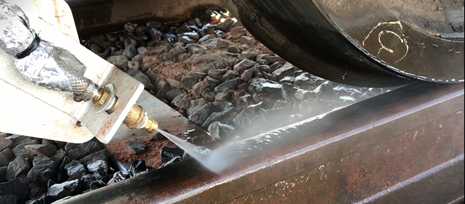Poor adhesion is in the news following the collision between two trains at Salisbury Tunnel Junction on the evening of 31 October. The RAIB has said that analysis of the South Western Railway train’s OTDR indicated that wheel slide was present, both when the driver applied service braking and after emergency braking was demanded, adding that wheel slide was almost certainly a result of low adhesion between the train’s wheels and the rails.
In autumn conditions, low adhesion is usually caused by leaf film that adheres to the rails and often the wheels too. Currently, lines are cleaned using railhead treatment trains, also known as RHTTs, but there are only a limited number of these trains available, so they cannot treat the whole of the network. RHTTs are also expensive to run, so they are mainly used to clean high-traffic, intercity lines, which means some lines are left untreated.
Rail Engineer has frequently reported on techniques to manage or remove leaf film, and, on 24 November, Northern Rail demonstrated two new leaf-busting technologies at its Allerton Depot. These were Cryogenic Rail Head Treatment and Water-Trak, last covered in Rail Engineer 191 (July /Aug2021). As Northern’s press release put it: “The disruption from Autumn leaf-fall for Britain’s railways could be a thing of the past – thanks to trials led by Northern and rail industry partners.”
Recapping, the debris from falling leaves can cause significant disruption to the network. Leaves stick to damp rails and passing trains compress them into a smooth, slippery layer, reducing the trains’ grip. This can cause delays to services, which lead to disruption for passengers, and the issue costs the railway industry millions of pounds every year.

Water-Trak
The Water-Trak team discovered that leaf-coated rails only become slippery if they are damp and noted that trains still stop safely in heavy rain. Water-Trak simply creates rainy-day conditions on the rail surface by spraying a small amount of water from the train onto the track when a slippery rail is detected.
Two Northern trains have been fitted with Water-Trak and have been successfully operating in passenger service since late October. The trials with Northern are being run thanks to funding from Network Rail’s Performance Innovation Fund.
Cryogenic Rail Head Treatment
This rail cleaning technique, developed by a team of researchers led by Professor Roger Lewis from the University of Sheffield, uses dry ice pellets in a stream of high-pressure air which freeze the leaves and then, as the pellets turn back to gas, increasing in volume by 800%, they are blasted away from the rails. The research team is running further trials with Northern throughout Autumn and Winter 2021/22 to test the cleaning system onboard passenger trains.
Coincidentally, on the same day, Roger Lewis was presenting Cryogenic Rail Head Treatment to an Institution of Mechanical Engineers seminar webinar where he described this and other research into the causes of leaf-induced low adhesion. Roger reported that the Cryogenic Rail Head Treatment system has been fitted inside a class 153 unit and will be tested on the little used Monk Bretton freight branch in early December, prior to in-service trials possibly on the Huddersfield to Bradford Interchange line where there have been several incidents in recent years.

A proposed redesign for 2022 will see the system fitted to the underframe of a vehicle and Roger hopes to be able to combine this with artificial intelligence techniques to analyse the images from forward-facing cameras to identify contaminated rails.

